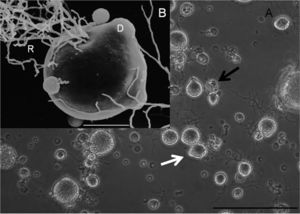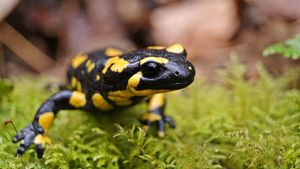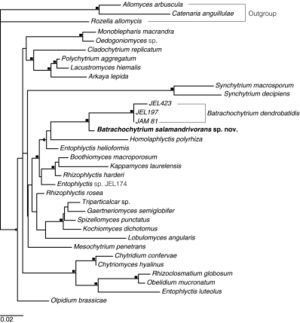Batrachochytrium salamandrivorans: Difference between revisions
Ellsworth1 (talk | contribs) No edit summary |
Ellsworth1 (talk | contribs) No edit summary |
||
| Line 42: | Line 42: | ||
==Section 4== | ==Section 4== | ||
[[Image:Yap_Map_of_Vulnerability.jpg|thumb|300px|right| Threat of Bsal to North America. A) Map of Bsal habitat suitability. B) Map of salamander species richness. C) Areas vulnerable to Bsal outbreak. Black squares represent major port cities for the international salamander pet trade. Image created by Yap et al 2015]] | |||
==Conclusion== | ==Conclusion== | ||
Revision as of 14:08, 24 April 2018
Section

By [Fiona Ellsworth]
At right is a sample image insertion. It works for any image uploaded anywhere to MicrobeWiki.
The insertion code consists of:
Double brackets: [[
Filename: Bs_pic_1.jpg
Thumbnail status: |thumb|
Pixel size: |300px|
Placement on page: |right|
Legend/credit: In vitro culture of Bs. (B) Scanning electron microscopic image. Photo taken by Martel et al, 2013. [2].
Closed double brackets: ]]
Other examples:
Bold
Italic
Subscript: H2O
Superscript: Fe3+
Amphibians world-wide have recently come under threat from a pathogenic fungus of the chytrid family. First documented in South American amphibians, Batrachochytrium dendrobatidis (Bd) has now been documented as causing chytridiomycosis in a variety of different amphibians in different parts of the world. Batrachochytrium salmandrivorans (Bsal), of the same family as Bd, is the fungal pathogen that causes chytridiomycosis in salamanders. Bsal, like Bd, has aquatic zoospheres that infect its host through their skin. The diseased salamander subsequently develops deadly skin lesions. One key difference between Bsal and Bd is the low thermal tolerance of Bsal. The pathogenic fungus likely originated in Asia, and then traveled to Europe via the international pet trade. Because of the great extent of the international salamander pet trade, it is likely that Bsal will eventually make its way to North America, and the rest of the world. Once it does, it is important for scientists to know as much as possible about the fungus, the disease that it causes, and what can be done to stop its spread. Scientists are currently working to answer these questions, in an effort to mitigate the mass extinction of amphibians worldwide which is currently underway.
Sample citations: [1]
[2]
A citation code consists of a hyperlinked reference within "ref" begin and end codes.
Section 1
Include some current research, with at least one figure showing data.
Every point of information REQUIRES CITATION using the citation tool shown above.
Section 2
Include some current research, with at least one figure showing data.
Section 3
Include some current research, with at least one figure showing data.
Section 4
Conclusion
References
- ↑ [An Martel, Annemarieke Spitzen-van der Sluijs, Mark Blooi, Wim Bert, Richard Ducatelle, Matthew C. Fisher, Antonius Woeltjes, Wilbert Bosman, Koen Chiers, Franky Bossuyt, Frank Pasmans Second cause of chytridiomycosis in amphibians Proceedings of the National Academy of Sciences Sep 2013, 110 (38) 15325-15329]
- ↑ Bartlett et al.: Oncolytic viruses as therapeutic cancer vaccines. Molecular Cancer 2013 12:103.
Authored for BIOL 238 Microbiology, taught by Joan Slonczewski, 2018, Kenyon College.




